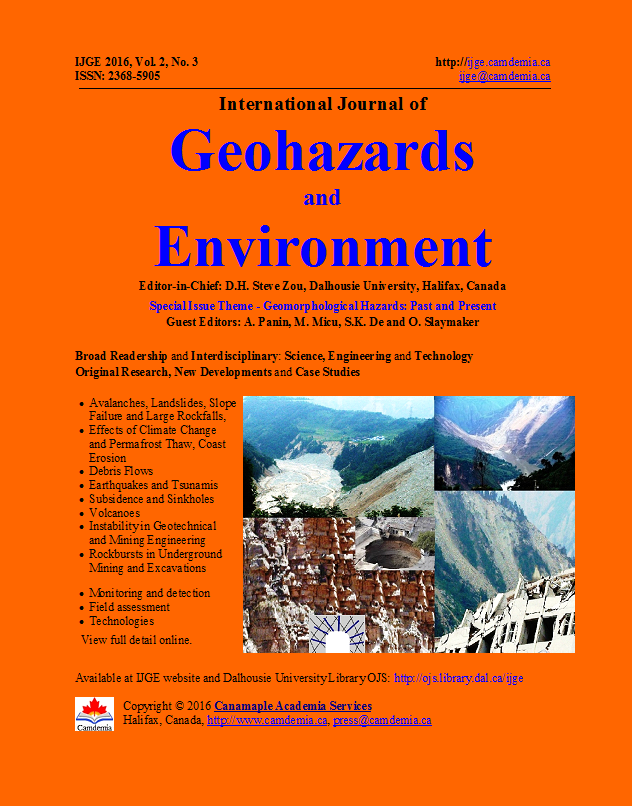The Role of Catastrophic Events in Slope Transformation of the Forecarpathians During the Subboreal-Subatlantic: A Case Study of the Archaeological Site Brzezie 26 Near Cracow (Southern Poland)
DOI:
https://doi.org/10.15273/ijge.2016.03.018Keywords:
Lusatian culture, Niepołomice-Bielcza Upland, colluvia, catastrophic events, geoarchaeology, middle bronze ageAbstract
The early Lusatian (about 1,300 - 1,100 BC) site in Brzezie 26 is located in the Niepołomice-Bielcza Upland, on the watershed undercut by a fluvio-denudational dry valley (dellen). Erosional relief on the Miocene clay is covered with the Quaternary loess. Luvisol (lessive soil) within the top layer of loess, on which the settlement was located, was covered with loess colluvium, with varying thickness (0.2 - 2.0 m). The colluvium could be distinguished in two members of different age, and accumulated in different sedimentological regime. The lower member, without clear sedimentological massive structures, lies on the “Neolithic-early Lusatian pottery pavement” within the top layer of luvisol. This member might have formed during the climatic phase dated to 3,200 - 3,000 BP, with clustering of catastrophic events well recognized in the upper Vistula basin and in the whole Central Europe. The upper member, with a small number of the early Lusatian, Medieval and early Modern pottery fragments, and very clear sedimentological structures, accumulated very quickly, probably during the Little Ice Age. The study results confirm that the biggest changes in loess relief in the upland occurred during the Subatlantic.Downloads
Issue
Section
License
Copyright, Terms and Conditions
The International Journal of Geohazards and Environment (the Journal) is published by Canamaple Academia Services (the Publisher) online with open access, under a Creative Commons Attribution-Noncommercial license (CC-BY-NC) (http://creativecommons.org/licenses/by-nc/4.0/). Authors (the Authors) submitting papers (the Work) for publication in the Journal automatically agree to the following terms and conditions.
1. Under the license (CC-BY-NC), Authors give permission for others to share and reuse the Work, as long as the original source and author(s) are properly cited (i.e. a complete bibliographic citation and link to the Journal website) and the material is not used for commercial purposes. Any sharing or reuse must however indicate the original CC-BY-NC license terms of the work.
2. Authors transfer and assign to the Publisher all copyright in and to the Work. However Authors retain all proprietary rights except the copyright, related to the Work and also retain the rights a) to use, reproduce, distribute, and publicly display the Work in any medium in connection with the Authors‘ academic and professional activities, such as teaching, presentations and lectures, b) to create derivative works from the Work and to make full use of the Work in future research and publications, c) to authorize others to make any non-commercial use of the Work, d) to make both the pre-published and final-published versions available online in institutional and/or disciplinary repositories or on their own websites with a citation and link to the original paper published in the Journal.
3. Authors warrant that the Work is their original work, it is not copied from anywhere or anyone else, they are totally responsible for the authenticity, originality, validity and accuracy, and the facts and views are their own, that the Work contains no matter which is defamatory or infringes any literary or proprietary rights, intellectual property rights, or any rights of privacy, and that the Work has not been simultaneously submitted to any other journals or publishers. Authors further agree that their manuscripts whether accepted or rejected will not be returned and the rejected manuscripts will be disposed at the journal editor's discretion.
Disclaimer: The Publisher, the Journal and the editors accept no responsibility for statements or opinions expressed by authors. Use of information and materials in the Journal is the sole responsibility of users.


